Table of Contents
The definitive guide to mobile app development is for helping entrepreneurs, executives, product managers, or anyone else who wants to get step-by-step guidance for mobile app development. You will get proven strategies, tactics, and templates which you can use for planning, ideation, business model development, marketing, mobile app development, QA, and launch. The goal is to combine a guided method for the mobile app development project to show you the proven path for successfully launching a mobile app development project. You will also find a launch checklist that you can use to define the app idea to launch roadmap, identify resources, and plan the events necessary for your mobile app development project.
This Definitive Guide to Mobile App Development is for you.
You have been dreaming about launching a mobile app to solve the problems you are facing in your business or you want to address the issues of people with the help of a mobile app in a meaningful, efficient, consistent and profitable way.
There are over 3.3 million apps on the Google Play Store and the Apple iTunes Store. Using the mobile app, you can play the game, connect with your friends and loved ones, buy things online, communicate with people, watch videos, listen to music, manage your business, manage your health, and do numerous other things. The stats below will further invoke your excitement if you have been thinking of launching a mobile app.
- As per Statista, the total revenue in the App market is projected to reach US$437.80bn in 2022 and is expected to show an annual growth rate (CAGR 2022-2026) of 6.58%, resulting in a projected market volume of US$565.00bn by 2026.
- The Apple App Store has 2.2 million apps available for download, and there are 2.8 million apps available for download on the Google Play Store.
- 21% of Millennials open an app 50+ times per day.
- 49% of people open an app 11+ times each day.
- • 57% of all digital media usage comes from mobile apps.
- The average smartphone owner uses 30 apps each month.
But launching yet another mobile app in already overcrowded space is tiring. There are millions of apps out there that have been discontinued or exist stale unable to attract the user traction. Many of them failed because;
- Failure to solve the real-world problem for people
- Inability to understand the target customer and their real problems
- Unable to choose a mobile app platform wisely
- Poor user experience delivering too many or too few features
- Improper testing
- Not able to market the mobile app adequately
- Poorly executed mobile app launch
- Not able to track the mobile app progress, customer feedback and update the app based on user feedback
To make your mobile app successful one, you must avoid the mistakes that come along the way and maximise your chances of success. This workbook will guide you with the ideation, planning, and launch strategy to make your mobile app idea to become a successful one.
The tools and the process outlined from here on will help you brainstorm your app idea to get it converted into a solid market ready mobile app on your own. We have used widely used and result-driven mental models, business modelling tools, design thinking, and blue ocean strategy to expand your mobile app idea development thinking with focus and curiosity.
Start your startup launch journey in a right way so that you assure of a higher chances of success and spend more time building your mobile app for a planned result.
With the help of this guided workbook, you can easily assess the opportunities, the associated risks, and launch a market-ready mobile app that inspires confidence at all stages of your mobile app launch journey. Let’s get started.
Step 1
Convert Your Mobile App Idea to a Great App Idea
Use the tools and process outlined in this guide to mobile app development, you will discover, brainstorm, analyse and find out the features and benefits that will convert your mobile app idea to a great idea.
Imagine the Big Picture
A little girl was drawing in her empty book. She was fully focused and rarely looked away from the paper.
“What are you doing?” asked her father, curiously looking over her shoulder.
“I’m drawing a picture of God.”
Her father frowned, “But people don’t know what he looks like!”
“Well, they will know now.”
Apply your child-like imagination and courage to draw a picture of distant future when you will make a compelling impact in the world with your ideas.
Here’s your chance. Let your imagination soar. Show your dreams to the world before you make it happen.
Let’s get started!
Sketch a picture of the impact your product will make on the world.
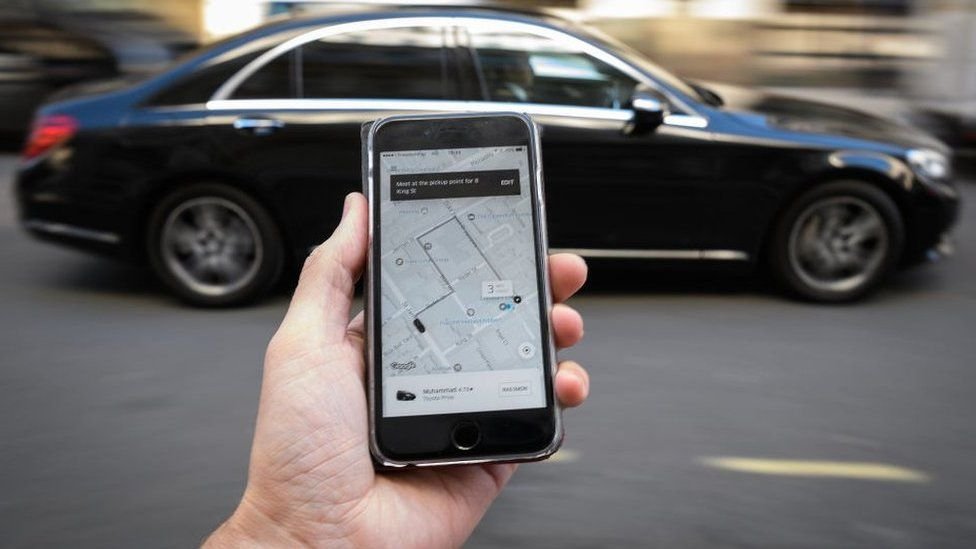
How to do it
- Embrace creativity
When are your best creative hours? For most people, it’s a few hours after they wake up. - Ask these questions:
What will make people feel great when they will use my product? Is there a real opportunity? Is it going to solve the real-world problem? - Erase all limits
Erase all ‘what ifs’ and close your negative thoughts.
Look at the picture below to imagine how the world has changed post the launch of taxi-hailing services like Uber and Ola. Paint a similar picture imagining how the world will look different once your idea becomes real.

Define Your Mobile App Idea
Customers, stakeholders, partners, and investors are inspired by good ideas. They love seeing passion, but they love a clear presentation even more. Making sure you get your message across is the most important part of attracting the imagination of stakeholders involved in your app success journey.
Sometimes it can even be a powerful opening phrase that grabs the attention of the entire room. But if that phrase is not defined, your proposal won’t be successful.
What you need to do is define your idea and make them want to be a part of it.
How to do it
- Who are the people you will be addressing? Make sure you understand the user.
- Define needs that are currently lacking.
- Develop insights. Research information and collect all necessary data.
- Combine the above three elements: User, Need and Insight. Develop the action that will drive your business.
Tips:
- Use your subconscious mind.
- Try reading, listening to music, meditate, go for a walk, while your mind gathers the facts.
- Note down the ideas that you come up with and then structure the sentences.
Briefly describe your idea in 140 characters
- For e.g: Forcing abstract ideas into concrete heads – Education.
- For e.g: I have an idea: I want to create a mobile app that runners can use to track how far they’ve run and then compete with each other by sharing their achievements via the Internet. They’ll track it via this technology in their shoe which will talk to their computer.
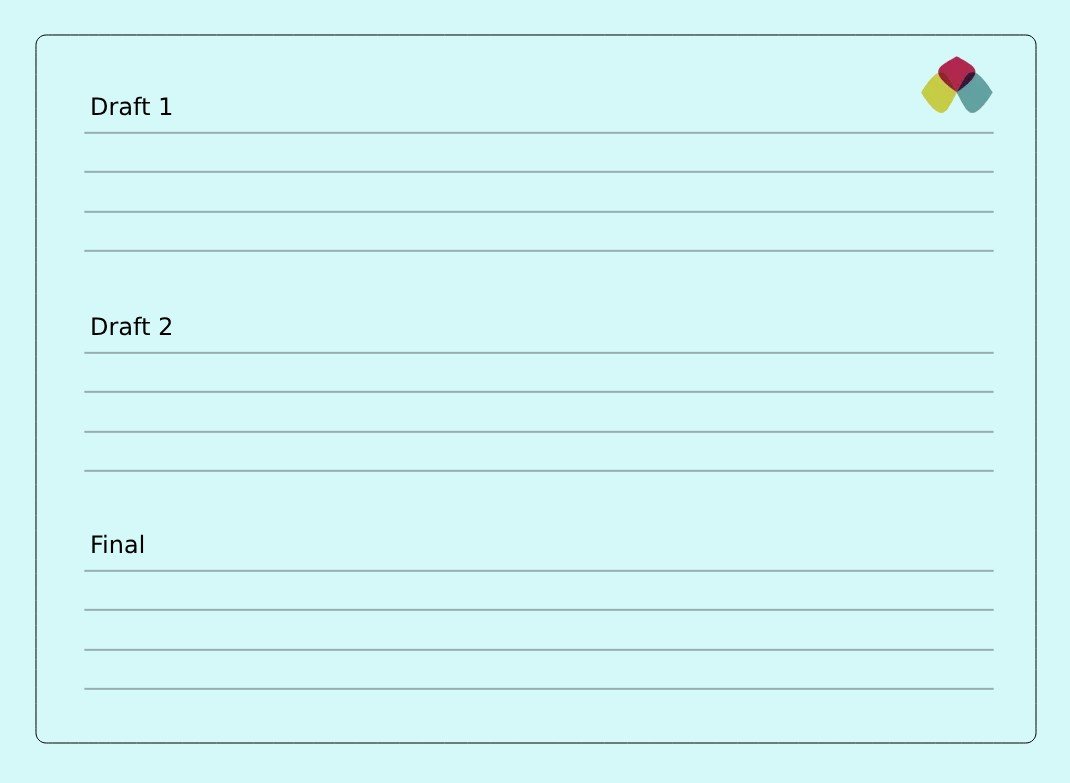
Discover the target customer of your mobile app
You will need the customer having an interest in downloading, using, and paying for the solution you will offer as a product or service.
Start identifying your customers, their demographics, and the
pain points you wish to address through your solutions. Your aim should be to also visualise whether the customer you have identified is a decision maker, buyer, influencer, user or a recommender.
How to do it
- Identify the broad level under which you will categorise the customer. For example, undergraduate students, any family with income up to 50000 per month, etc.
- Classify the customer demographic such as age, gender, income, nationality, etc.
- Define the pain point that you are solving for the customer segment.
- Name the customer if you can imagine anyone in your surrounding or reference.
- Answer the question why you feel the named person is your ideal customer and how you will reach out to them to validate your hypothesis.
Tips:
Be as realistic as possible. If you are not sure about the real customer, search the internet for the exact buyers of the similar product or services. You can consult your friends for help.
Identify the customer segments that you think would be the beneficiary of your idea:

Name the 5 customers whom you can interview based on the above Task 1 to validate the pain points:

Discover the Pain Points and Competitive Landscape
You have identified your customer segments and the pain points you are going to address through your product or service for them. Now, you need to define the competitive landscape to see how your competition is addressing those points, what would be the cost and efforts they’d need to catch up for addressing the pain points better than you do.
Your aim should be to know the competitors whom you’d face when you launch your product in the marketplace:
- How quickly will the competition catch up with you in solving the problem better than you?
- How will they seize your size through pricing, positioning, and marketing?
- What else would they do to achieve better customer success?
How to do it
- Research the internet to find the businesses addressing the problem.
- Go to Quora, Social Media platforms, Forums and feedback website to find out about your competition.
- Speak to people who are the users of the product to understand their pain points.
- Read the review on eCommerce website if the product is sold there.
Tips:
Visit the competitor website.Follow your potential competitors on social media.Perform google search trend analysis on the keywords relevant to your business.
List out the pain points and describe how the competition is addressing the same.
- Research and identify minimum 3 competitors who you think are addressing the pain points of the customer.
- Include the pain points that no competitor is addressing which may provide a disruptive opportunity in the segment.
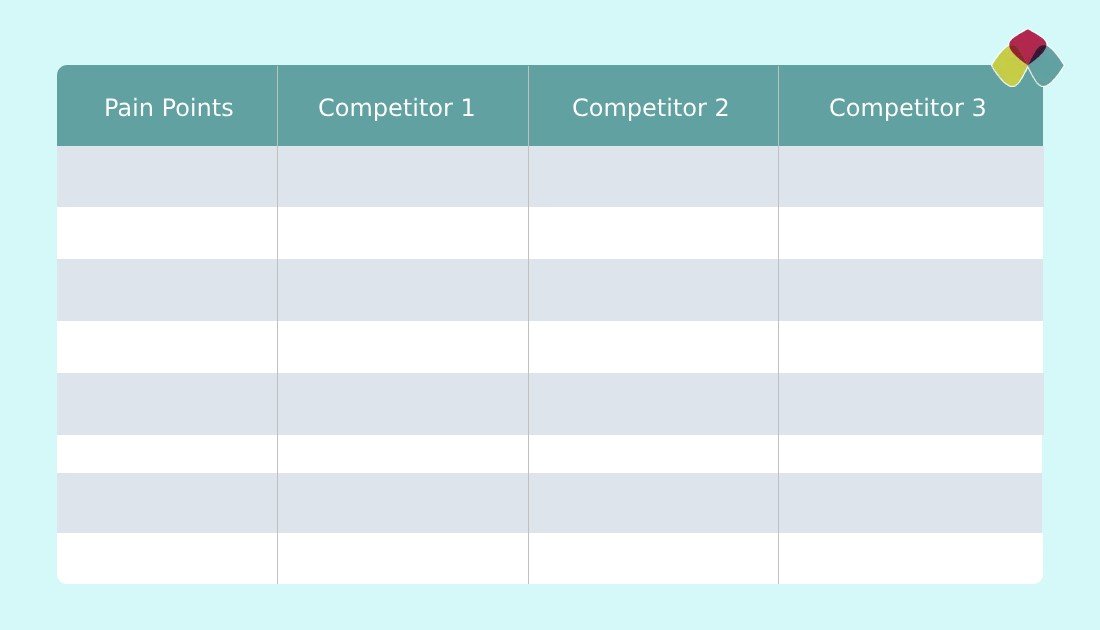
Prepare Product / Solution Hypothesis
When you read a book, listen to music, use a product, service or venture, you resonate with it. You feel the power that lies in it.
Think about the solution that your product is going to offer in a way that it allows the consumer to connect with emotions, promises, and the thing that your product is going to do for them.
The question you should ask?
How can I create an experience that allows my target customer to feel my soul through my work?
How to do it
- You need to be your creative best to think of an nth way to solve the problem.
- Think of a potential scenario that will emerge when your solution is used by the customer.
- Look at the opportunities and challenges you are addressing and the best possible thing you can do to address it.
- Look at easy, better, comprehensive and optimum way to define your solution.
Describe all possible scenarios and contexts under which your target customer will benefit from your solution. Establish the notions with the facts and solutions for each scenario.
- Get an insider view of the current solutions.
- Look at adjacent industries and market segments to find complimentary hypothesis and incremental ideas.
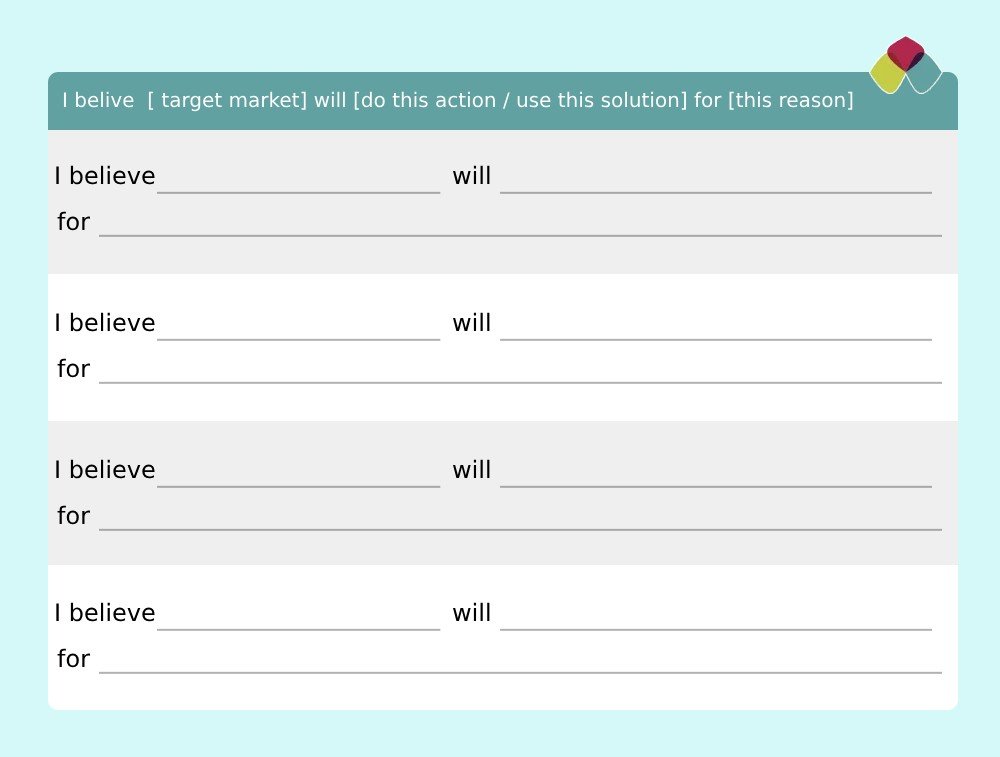
Validate your Mobile App Idea
“No Business Plan Survives First Contact With A Customer.”
Steve Blank
Your aim is to build a product that generates significant customer interest and attracts the customer to buy and pay for it. Before you go any further, you should validate three things. First, whether the problem and the pain point as you have defined are correct or not. Second, whether you are able to reach out to the customer through the channels as you have described earlier. And third, whether your solution hypothesis resonates with what your customer thinks about the way you address their problem or not.
How to do it
- Your goal is to understand the insights to help you focus on the potential solutions and the resulting action.
- If you find that the customer you are interviewing is not the right one, change your customer segment and redo the validation exercise. Pivot until you find the right customer.
- Demonstrate to your potential customer about the factors through which you think of addressing the solution better than the current solution customer is using.
Tips:
Establish an open environment for a meaningful conversation with your customer.
Your aim is to find what customer thinks, how they think the solution should be provided, how frequently they use the solution, and whether they would be willing to use the solution that you are thinking to offer.
Your aim is to communicate the pain point to your customer and observe how they resonate with it and what kind of solution they are looking at:
- Your aim is to turn customer interview to further your experiment for building your startup.
- Don’t put the answers in front of the customer. Observe what they feel and express.
- Be clear and specific in asking the actual question.

Define Your Mobile App Idea
Your aim should be to define your company in a way that it attracts the listener and communicates your idea in a clear and concise manner. The best way to think about defining your company is “How would you announce your company to the world on your day of launch with one tweet?”
How to do it
- Define “Mobile App Idea” using relevant, attractive, and meaningful name. Avoid trademark violation, pronunciation and spelling difficulties.
- A “defined offering” should contain the strongest value proposition that will make a great unique selling proposition and highest recall value in the listener’s mind.
- The “target audience” should be exactly the customer segment you have identified in the earlier exercise.
- “Solve a problem” should be the exact problem that you are solving with your idea.
- The “secret sauce” is your key solution that will make it stand out in the marketplace.
Tips:
Use strong verbs and adjectives.
Keep it simple, clear and understandable. Avoid jargons.
Focus on clearly defining your vision, mission, and purpose.
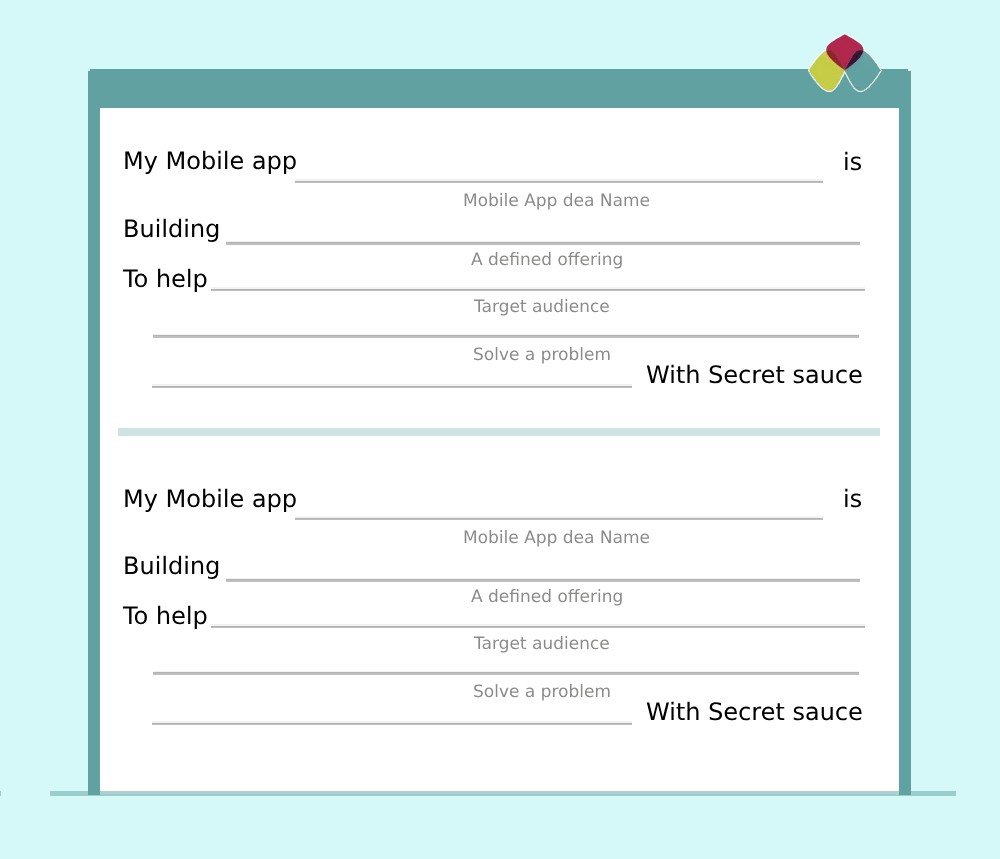
Describe Your Mobile App Idea
“That’s interesting. Tell me more.”That’s the real answer you want from people when you describe your mobile app idea
Describing your idea is by no means an easy thing to do. How do you articulate something that’s only visible in your imagination? How can you make another person understand and get on board? Here’s how.
How to do it
- Describe your idea by answering these questions:What is the problem?Who experiences that problem?How do you want to solve that problem?Why is this a better solution?
- Prepare rough draft on paper and a refined copy on computer.
Tips:
Explain your idea to someone and see if they can guess what you’re talking about.
Find someone who knows nothing about your business and someone who knows something about it
Write a short note describing your idea in a most compelling way.
- Include the value propositions, solutions, and market segments you are targeting.
- Specify your thoughts on the impact that your idea will have on people, society and the world.

Classify Needs, Wants, and Desires
When your mobile app faces the real customer after the launch, it will need to excite the customer to download, use, retain, and make it as part of their daily habit to use your app.
Most of the apps left abandoned either present too few or too many features to be of use to them. Instead of getting lured by the feature-loaded app, you need to offer the features that meet their needs.
This exercise will help you figure out your priorities and thereby help you identify and build a USP for your product.
How to do it
- Prepare an exhaustive list of the all the features that you want your mobile app to have. List all possible features that will make it a perfect app to provide all that you want.
- In the Step 2, categorise the features you have listed in 3 columns as Needs, Wants, Desires.
- Needs if it is critical to the product,
- Wants if it is supplemental to the main product.
- Desires if it is outside of your main product.
Reflect on your problem statement while doing this.
- Once all the features are sorted, look at each column and the features in them and verify their importance once again as High, Moderate & Low.
Step 2: Classify your mobile app features into Needs, Wants & Desires (keeping your problem statement and customers in mind

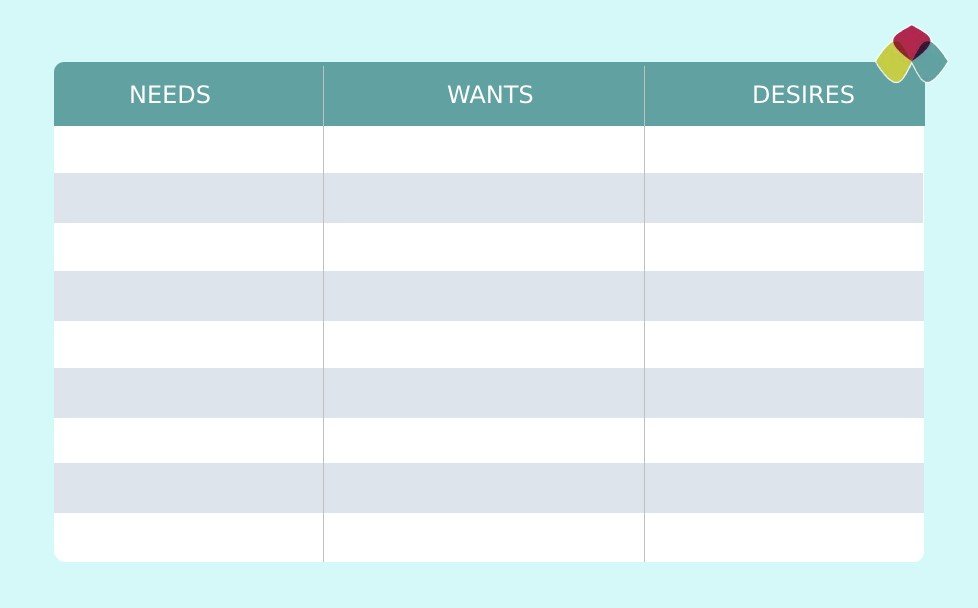
Step 2
The Business Model of Your Mobile App
Crafting a solid business model is pivotal for mobile apps, driving success through innovation and market viability.
If you have moved so far, it shows that you are ready to convert your mobile app idea into a launchready product. Before you start investing your time, resource, and money, it would be great if you can answer a fundamental question: “What is your business model — how will you mobilise the resources to get your idea to the market and make money?” We advise you to build and understand the business model of your mobile app idea. It would be best if you put together the facts representing the building block in the creation of the product:
Customer segments:for whom you aim to create value? Who are your most important customers? Value Propositions: what do you offer to whom? What value do you deliver to a customer in a given segment? What needs do you satisfy when they use your app? App Distribution Channels: how do you reach each customer segment? What is easiest for the customer? Marketing: How do you get your customers to download and install the app? How would you entice them to sign up and use it? What marketing strategy you will use for your customers to continuously use it? Revenue Sources: What will your customers pay? How much? How would they prefer to pay? Cost Structure: what costs are required to build, launch, and grow the mobile app? Which is the largest? What fixed costs, and what variable costs? How would you mobilise the funding sources to meet these costs?
Segment Your Customers
You have already identified the target customer segment for your apps above. Here your goal should be to segment your customers based on their demographic, geographic, psychographic, and behavioural dynamics.
More the clarity you have about your customer segment, it would help you develop targeted marketing to acquire, activate, monazite, retain, upsell, and reactivate the dormant users.
How to do it
- Know your actual users — What acquisition channels they use? Why would they use your app? How easily are you solving their pain points?
- Is your customer segment big enough for you to launch the app?
- Conduct a validation exercise to check whether you have identified your customer segment correctly, and it resonates with their needs.
- Revisit and refine your customer segments based on the shifts in size, behaviour, and engagement.
- It would be best if you defined goals for each customer segment to develop an actionable, measurable, and result-driven marketing and engagement strategy.
Step 1: Define and list the customers segments

Value Proposition
A value proposition outlines the benefit that your mobile app promises to deliver to users. With over 2.8 million apps in the Google Play Store and over 6000 new apps launched every day, the only way to stand out is to provide a compelling value proposition that lets people know why they should use your app instead of your competitors’.
Explanation of Benefit(s): What value will users obtain by using your app?
Clarity: Your value proposition should be easy to understand, without using corporate jargon.
Conciseness:: Keep your value proposition straight to the point. Readers should be able to comprehend your message in five seconds or less.
Differentiation: How is your app different than the competition?
How to do it
- You are not writing a slogan, catchphrase, or a mission statement about your app.
- A value proposition should answer the question: “Why should your customer segment care about your app?”
- Benefit, clarity, conciseness, and differentiation should be included in your value proposition statement
- It should be concise and tell the user exactly what they’re going to get if they use the app.
Your value proposition should demonstrate what your customer wants, what features and benefits you are offering, and how your competitors are addressing the customer needs?
Step 1: Define and list the customers segments
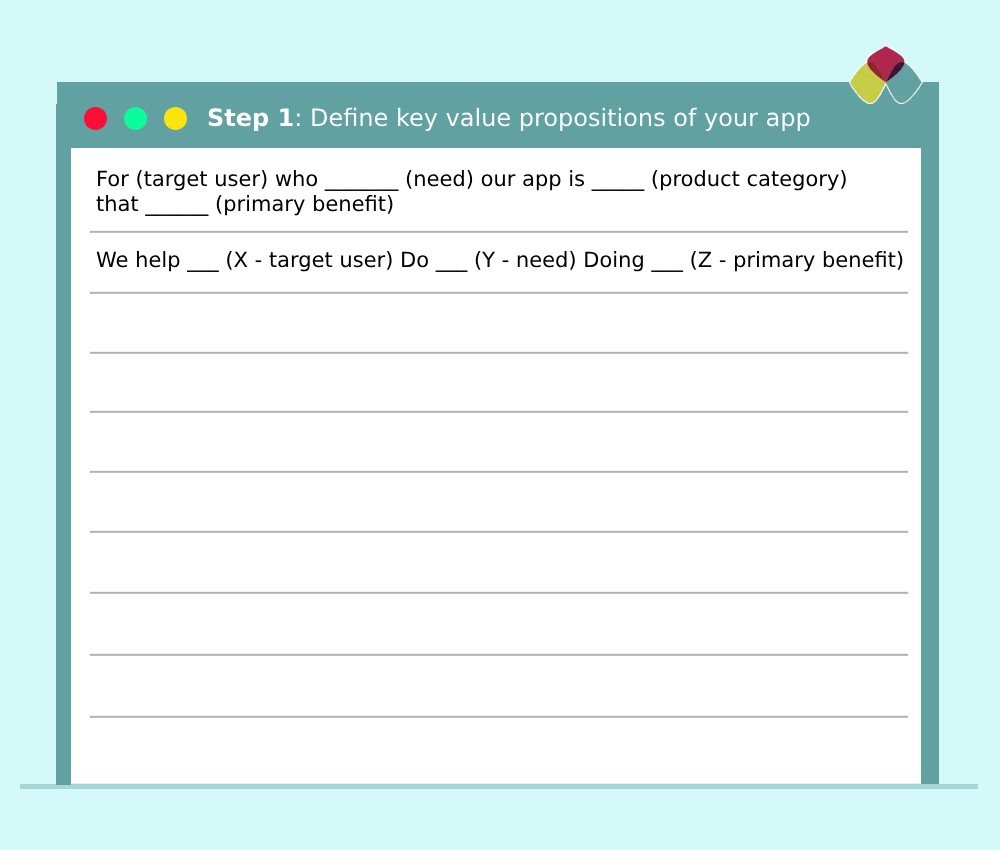
Identify App Store for Mobile App Distribution
Once you build your app, you will need to distribute your apps across the different channels so that the customer can find it to download.
As an App creator, you are no longer limited to the Google
Play Store and the Apple App Store. Sometimes, it is better to list your app on more than these two popular stores for your apps to become far more discoverable via these platforms.
After you finalise the app stores, you need to plan the app store optimisation (ASO) carefully. Your apps discoverability and download very much depends on how well you have optimised your app for the store listing.
How to do it
- Prepare the list of app stores most suitable for your target audience.
- Research to find out their unique value propositions and whether they have the audience matching your customer segment.
- Finalise your app title with the highest level of relevancy and brand recall value. It will help you earn search traffic, rank higher, and gain word of mouth.
- Correct identification of keywords will help app stores position your app for better search results, discoverability to help your target audience find it. Look at the top-ranking apps as well as your competitor’s apps for their keywords.
Each app stores have their guidelines for the listing. Study the guidelines and strictly follow it to avoid delays or refusal of your app listing.
List your app stores, app title and keywords
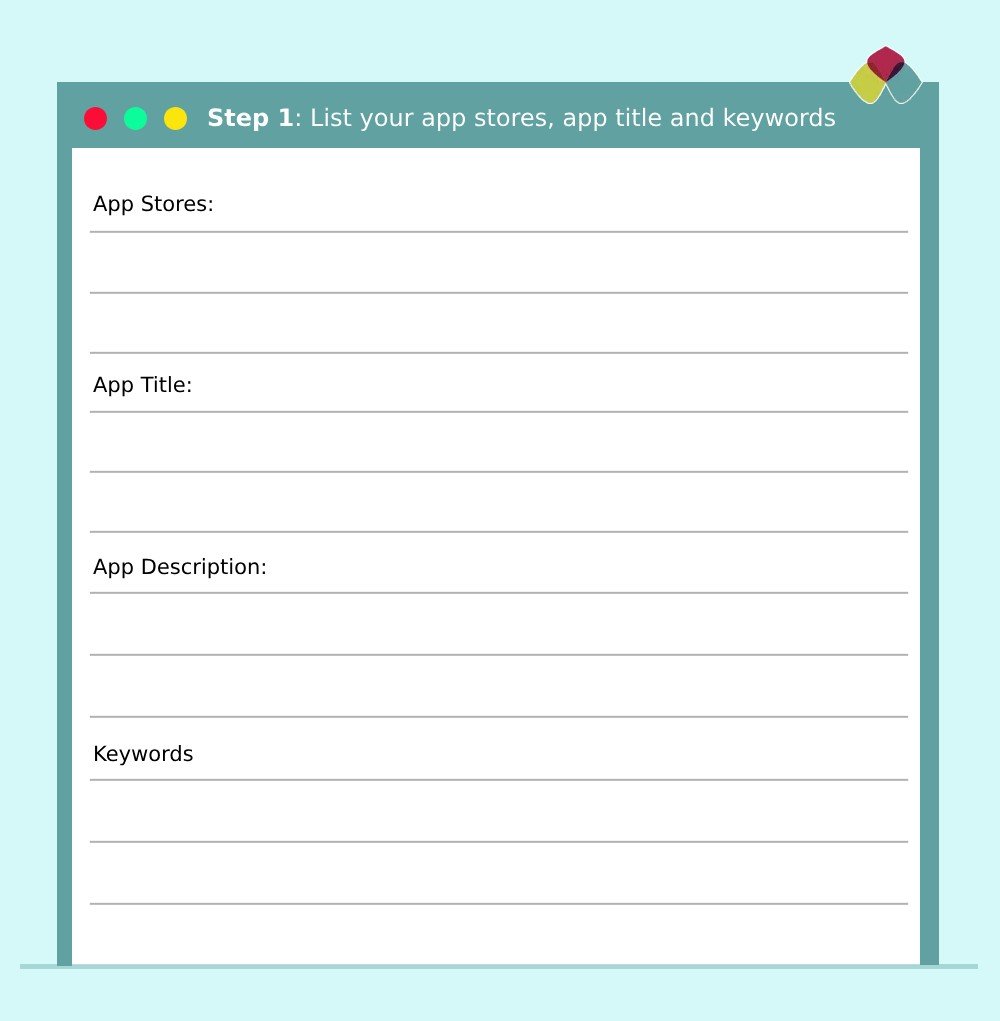
Prepare the Marketing Plan for Customer Acquisition
Making your mobile app is somehow easier than getting people to know about it, download, use, pay, and continue to use the app.
While you are completing your mobile app development, you must spend a considerable amount of time figuring out how would you reach out to your target customers.
How to do it
- Your marketing plan should include the website, social media, growth hacking techniques, content marketing, press releases, and influencer marketing.
- Identify early adopters who can use your app, provide feedback, and also promote it.
- Just make sure that you’re promoting your app through the right channels that are most commonly used by your target audience.
- Add the additional marketing outlets not covered here and remove what is not relevant to your app.
Use the mobile app marketing template on the next page to
identify the marketing touch points you should consider.
Mobile app marketing plan

Know How Will You Make Revenue
No business can be sustainable if it’s not generating
revenue. At this point, you need to discover the revenue model, which will help you sustain, scale, and grow your mobile app business. Here are eight unique app revenue models you can think of to earn the revenue from your mobile app:
- In-app advertising, if you are going to offer your app for free/freemium basis to your customer
- You can use customer data for lead generation or affiliate marketing opportunities.
- Selling your data to other companies that may benefit from the customers you target.
- You can charge transaction fees, especially if you are building a marketplace or product discovery app.
- You can offer a freemium option for additional features and benefits to your customer.
- You can sell complementary products and services to generate additional revenue and profit from your app.
- You can sell Virtual goods like ebooks, music, and courses to generate revenue.
- Software as a Service (SAAS) subscription fee
How to do it
Determine your revenue model based on the dynamics of your customer segment and market realities.
Before you determine the revenue, consider tractions, engagement, frequency of visit/usage, and the pricing.
Give due consideration to your product roadmap and customer acquisition before deciding on the revenue.
Mobile app revenue model

Know the Costs for Developing and Running Your App
To design, build, launch, and run your app, you will need to provide for the costs. These are the main costs that you will need to plan for:
- App development cost
- Server and hosting cost
- Software license fees
- App website development cost
- Employees, consultants, and other staff required to run the app.
How to do it
Here is how you should plan for the various costs:
- Based on the complexity of the app, calculate the time required for building the app, and then estimate the development cost.
- You can write a brief scope of the project, post it on the freelancer platforms like Upwork and Fiverr to get the quote. It would help you know the estimated cost for design and development.
- Along with the app development cost, provision for hosting, server, software license, marketing, customer support, and maintenance cost.
- App website development cost
- It would be best if you compare revenue with the cost to check what it will take you to make the profit.
Mobile app revenue model

Step 3
Make a Prototype and Validate
Prototyping and validation fuel mobile app success by refining ideas, ensuring user appeal, and market readiness.
More and more apps are getting launched every day. Many of them do not attract user attention as they don’t provide meaningful solutions to the problem customers face. Since people use their mobile devices everywhere, offering user-friendly and engaging mobile experiences play a central role in creating brand affinity. Prototyping your mobile app beforehand will help you explain the features and benefits to the development team as well as validate your app idea with the target customer in advance.
Mobile app prototyping is a form of user research to validate the strategic design direction of a product. A prototype is a preliminary visualization of a working product. In mobile app development, prototypes build an understanding of the product’s look and feel, which helps test how people use and react to your offering. Using a prototype for usability testing allows for enough time to make changes to critical design issues before the product reaches development and it becomes too late to fix the user experience issues.
Follow the steps outlined in the following pages for app prototyping and best practices to keep in mind throughout the process.
Perform Storyboarding to Know The Complete Picture
Have you ever tried making a business video?
You probably should do. It helps to visual your ideas to life for people to understand and give constructive feedback.
One of the key tools of sharing your business vision is a storyboard. A storyboard is a comic book version of your script. It will help you identify the resources you’ll need to complete the story and even find problems and solutions that you might’ve completely missed before.
So grab some paper and a pen and start storyboarding!
How to do it
- Create blank slides – Leave space to write notes and lines from the script for each frame.
- Establish a timeline – How long will it take to produce this video?
- Identify key scenes – Describe and sketch your frame. Determine action and dialogue.
- Draft a script – Refine it until it’s clear and concise.
- Get Feedback – Use it to brainstorm ideas or evaluate a proposed solution.
Tips:
Get Feedback – Use it to brainstorm ideas or evaluate a proposed solution.
Pick a theme. Use video infographic.
Ensure that it is visually consistent from beginning to end.
Get Inspired: Below is the storyboard example of movie booking app.
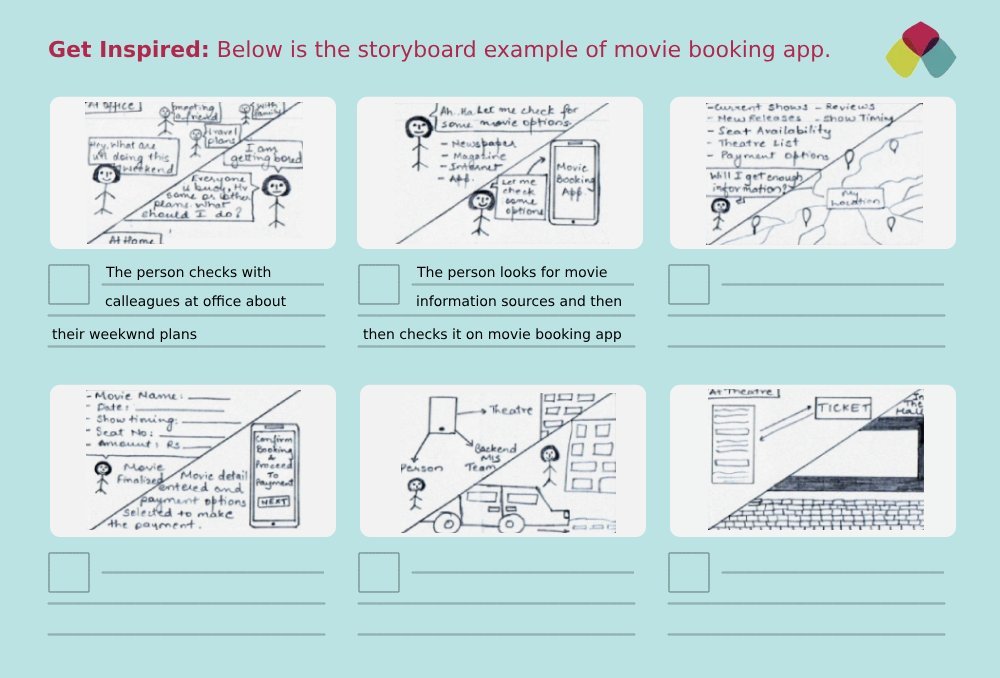

Prototype/Wireframe Your Mobile App
Your ideas should be modelled in a tangible way such that it functions properly, conveys the right message and is suitable for the target audience. This is where prototyping plays an important role to ensure that your product is serving its purpose. If there are any errors or problems then the prototype is improved and tested again before it is fully functional and launched in the market.
Prototyping can range from paper to service prototypes. Wireframes are majorly used in the creation of web and mobile application solutions. The details of wireframe depend completely on the creator and their idea of website/ mobile app and its elements. Now let’s get started!
How to do it
- Discuss tools – which tools do you need for prototype/wireframe.
- Think about your business – What are the most important aspects and information you want to illustrate? Detail only what is necessary.
- Try to create a model from as few parts as possible, assembling smaller sections.
- Identify the ways users would discover, understand and engage with it.
- Refine the prototype based on user feedback and try different versions to see how people react.
Tips:
Have an outsider try to use an aspect of your service with your prototype.
Think through how you could make it before jumping in. Do little experiments to see if the approach would work.
Get Inspired: Below is the mobile app wireframe for shipping goods.
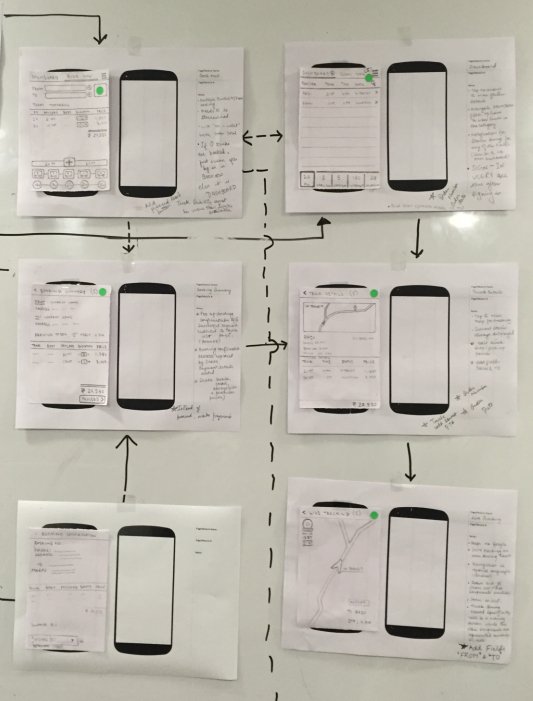

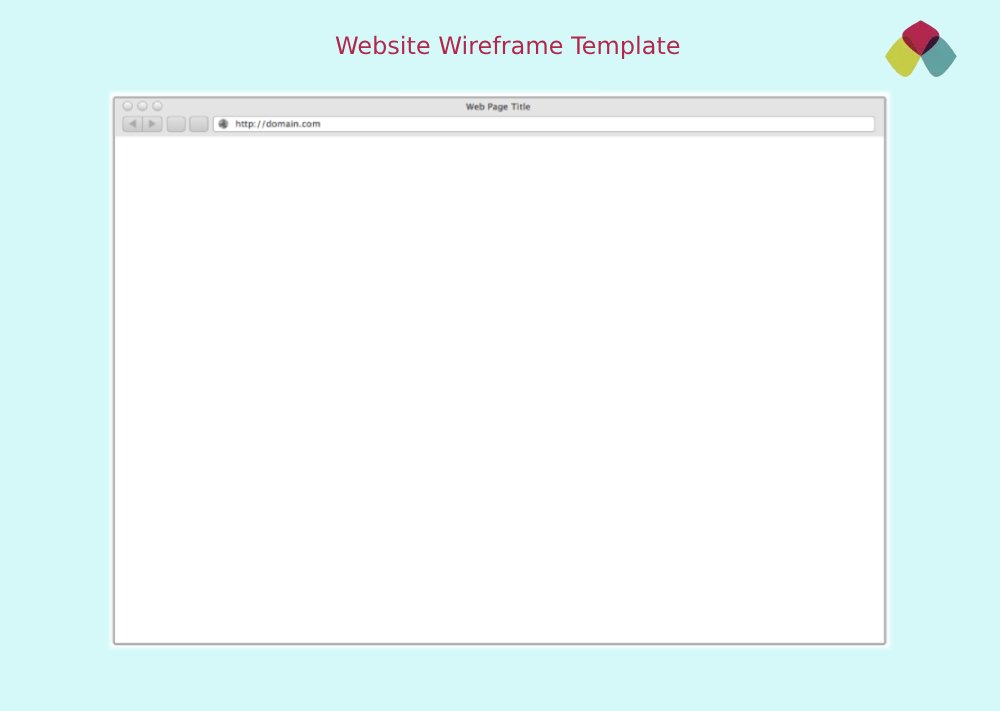
Step 4
Developing the Mobile App
Developing a mobile app bridges vision to reality, delivering user-centric solutions for seamless experiences and market impact.
You have traveled so far to make a compelling app delivering a unique value proposition to your target audience. It’s time you need to start the actual process of building your mobile app. Whether you are going to code it yourself or you are going to hire an external agency to help you with the mobile app, you need to follow the process of creating the mobile app.
Knowing each step involved in the app making process will help you know the roadmap and handle the process well. It is an advantageous process and can be quite lucrative. Also, there might be some temptation to skips steps in this process, but this guide is built upon years of experience working dozens of app that I have got involved in launching successful mobile apps.
Lets get started to decide on the most crucial decision that will help you deliver an awesome mobile app to your target customer using the most appropriate technology stack.
Make Technology Architecture Decisions
Selecting the right technology stack to build your app becomes
overwhelming. You have numerous choices to choose the programming language, database server, API methodologies, and hosting services. It would be best if you decided beforehand about the tech stack before you commission the actual product development to deliver high performance, availability, seamless experience, and smooth operation. Now let’s get started!
How to do it
- Mobile app front end:
- Platform-Native apps – the app has to be coded separately for Android, iOS, etc.
- Cross-platform native apps – using the modern stacks that allow the cross-platform native-like app development
- Hybrid apps – using the third party integrated app development system.
- Backend API and Servers required for the app’s availability, performance, and scalability.
- The programming language you will use for coding the mobile app.
- Database Server for storing data.
- Hosting environment – you can host your system on an owned server or you can buy the cloud server like Amazon AWS
Tech Stack: Below specify the technologies you are going to use

Have Your Mobile App Idea Product Roadmap
You know the needs, wants, and desires of your target audience. You have also made the wireframe to showcase to your target audience. Based on the learnings of the above, you should create your roadmap clearly defining your path to deliver the mobile app to your users.
How to do it
- The app roadmap must show what your app could one day become and what it needs to be to attract the imagination of users, influencers as well as other stakeholders.
- Your day one version is often called a Minimum Viable Product (MVP). Write your features on the order of priority based on what you consider as core functionality, what is needed to gain user attention, and what you can add later.
- The roadmap should be a running document. You will keep revisiting and revising based on the feedback of your users.
Build the Mobile App Development Roadmap: Draw your roadmap aligned with the needs, wants and desire you have discovered earlier.

Start Converting Your Mobile App Idea to a Functional App
You will need to identify the right team for developing your app and implementing the design, styles, and functionality as you have planned for your app. A group of project managers, product managers, designers, and QA tester will work together for technology development.
You must explain and develop an understanding of the project goals of the application as a whole, and for the specific feature, they are working on. Nobody is more in-tune with that particular feature than the assigned developer. They should understand the intent of the requirements.
During development, use project management software to assign the milestones, tasks, and team. It will allow you to monitor the project progress as well as solve issues faced by the development team on day to day basis.
How to do it
- Select the project team carefully. Provide special care for the skills and understanding your team has about the project.
- Use project management tools to plan, monitor and communicate the development progress with the team.
- Conduct a detailed briefing session with the entire team so that they understand the specs and develop software as per the plan.
- Conduct periodic review meeting with the team to resolve any doubts and issues they may face during the development phase.
Use the right project management software to setup the timeline, milestones, tasks and team responsibility

Start and Complete the Mobile App Testing
There are two main components to deploying your mobile app for your target customer to download and use it. The first involves deploying your web server (API) into a scalable production environment. The second is deploying your app to the Google Play Store, Apple App Store, and other app stores as you may have planned.
Functional Testing – Testing to ensure the feature works as described in the requirements. Usually, a QA team will have a test plan with a list of actions and the desired app behavior.
Usability Testing – Testing to ensure the feature is user-friendly and is as intuitive as possible.
Performance Testing – Performance testing is typically more important in later sprints, but keep an eye on the app’s responsiveness as you move along.
Fit and Finish Testing – Designers should review each feature and ensure that their vision was implemented as described in the design.
Regression Testing – Good QA teams will have a list of tests to perform at the end of each version, which will include tests from the previous version.
Device-Specific Testing – There are tens of thousands of device and operating system combinations in the world. When testing, make sure you try out your app on numerous screen sizes and OS versions.
User Acceptance Testing – This is testing performed by either the app owner or future app users. Remember who you are building this app for and get their feedback throughout the process.
As problems are discovered in this phase, reassign tasks back to
developers so that the problems can be resolved and the issues closed out. Once testing has been completed and each task is done, move on to review.
“If you don’t like testing your product, most likely your customers won’t like to test it either.”

Step 5
Launch the Mobile App
The launch of a mobile app sparks innovation, unlocking its potential to connect, engage, and transform user experiences.
It is important to perform testing of app using different tools and techniques so that you are shipping the product that works. We advise you to get your app tested by people who aren’t part of the development team. This will help ensure a more genuine testing experience. Several types of testing should occur during the testing phase. These typically include the following:It is important to perform testing of app using different tools and techniques so that you are shipping the product that works. We advise you to get your app tested by people who aren’t part of the development team. This will help ensure a more genuine testing experience. Several types of testing should occur during the testing phase. These typically include the following:
Backend Server
You will require cloud-hosted servers to host databases, APIs, and other server applications for your mobile app to work. Properly configured servers are scalable to meet your current and potential user base, while not being needlessly expensive. You also need to take care of scalability to ensure your servers don’t fall apart, just when it gets popular.
App Stores
Submitting your apps to the app stores is a moderately involved process. You need to make sure your apps are correctly configured for app store release, fill out necessary forms for each store, submit screenshots and marketing materials, and write a description. Once your app is submitted, it will be live in Google later that day and in Apple within a few days, assuming everything goes smoothly.
Monitoring
To handle the crashes, bugs, and issues, you will need to provide for adequate monitoring to fix issues related to performance improvements, changes, and new features.
App Store Management
App store ratings and reviews are essential, especially when your app is new. Whenever a new review is left on your listing, make sure to engage the reviewer. Thank users who give you great reviews and try to acknowledge and address their issues. Users don’t expect app developers and owners to provide a hands-on level of service, and that helps goes a long way in boosting your online reputation.
Further Iteration and Improvement
Set the process to accumulate and use the information you receive from your users and your monitoring platforms. Then repeat parts of this mobile app development process. Continue to improve your app, your conversion rates, your install base, and of course, your revenue. Mobile apps are fluid. Take advantage of that by continuing to grow and improve.
“If you don’t like testing your product, most likely your customers won’t like to test it either.”

Useful Tip:Defining your idea in the format above is to step out from your subconscious into your conscious mind to describe in a way that if you had to tell the world about your idea right now, how would you describe it?
I hope now you have an adequate understanding of what it takes to build a great idea. Follow along to learn how to filter out the noises and discover your strengths to build your dream business.
Appetals Solutions, under the leadership of its founder Ishwar Jha, an award-winning technologist, former CEO of Digital Business at Zee Entertainment, and CIO of Sony Music India, offers product development consulting to the company of all sizes. Learn more by clicking the button below.

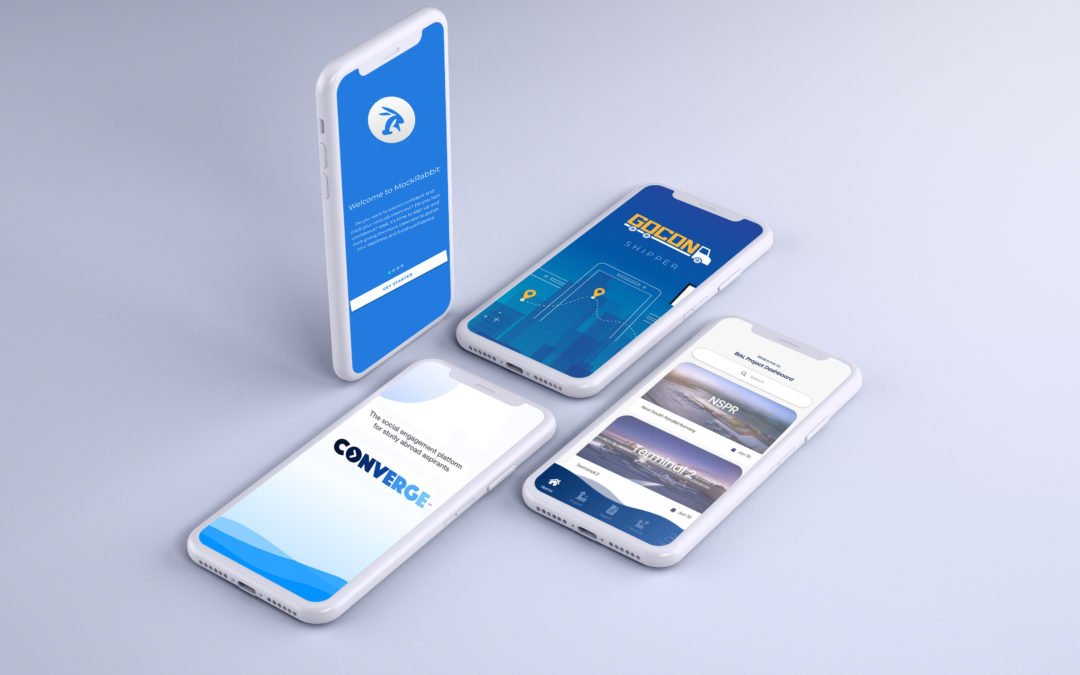
Recent Comments